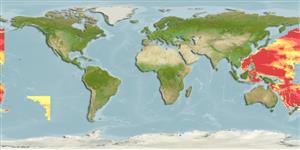>
Aulopiformes (Grinners) >
Paralepididae (Barracudinas)
Etymology: Magnisudis: Latin, magnus = large + Latin, sudis = esox, fish of the Rhine, cited by Plinius 9.15; it also means "stake" (Ref. 45335).
Environment: milieu / climate zone / depth range / distribution range
पारिस्थितिकी
समुद्री बैथीपिलाजिक; गहराई सीमा 876 - 2000 m (Ref. 128303). Deep-water
Indo-West Pacific.
आकार / वज़न / Age
Maturity: Lm ? range ? - ? cm
Max length : 28.0 cm SL पुल्लिंग / अलिंग; (Ref. 128303)
Short description
पहचान कुंजी | आकृति विज्ञान | मौरफोमैटरिक्स
पृष्ठीय सौफट रेज़ (सम्पूर्ण) : 11; ऐनल सौफट रेज़: 22; जानवरों की रीड़ का जोड़: 61.
Life cycle and mating behavior
परिपक्व अवधि | पुनरुत्पत्ति | मछलीऔ का अंडे देना | अंडे | Fecundity | लार्वा
Ho, H.-C., S. Oktaviyani, T. Peristiwady and H.H. Tan, 2021. A rare species of scaled barracudina (Paralepididae) newly collected from the eastern Indian Ocean off Indonesia. Raffles Bull. Zool. 36:486-490. (Ref. 128303)
IUCN Red List Status (Ref. 130435: Version 2024-2)
Threat to humans
Harmless
Human uses
साधन
Special reports
Download XML
इंटरनेट स्रोत
Estimates based on models
Preferred temperature (Ref.
123201): 2.6 - 4.3, mean 3.5 °C (based on 397 cells).
Phylogenetic diversity index (Ref.
82804): PD
50 = 0.6250 [Uniqueness, from 0.5 = low to 2.0 = high].
Bayesian length-weight: a=0.00224 (0.00090 - 0.00555), b=3.14 (2.92 - 3.36), in cm total length, based on LWR estimates for this (Sub)family-body shape (Ref.
93245).
Trophic level (Ref.
69278): 3.9 ±0.6 se; based on size and trophs of closest relatives
लौटाव (Ref.
120179): ऊंचा, न्यूनतम जनसंख्या दुगनी समय अवलागत 15 महीने। (Preliminary K or Fecundity.).
Fishing Vulnerability (Ref.
59153): Low vulnerability (24 of 100).
